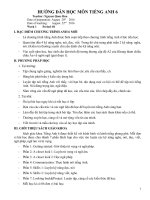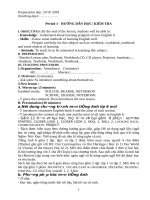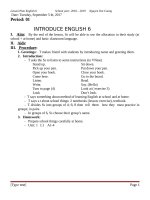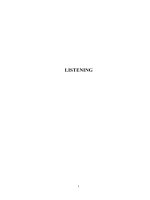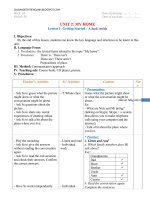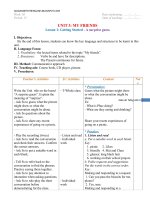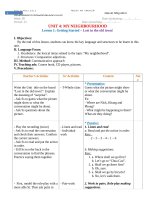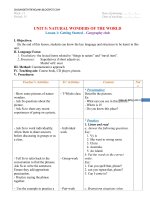Tiếng anh 7 (sách mới) giáo án cả năm lâm nguyễn trần
Bạn đang xem bản rút gọn của tài liệu. Xem và tải ngay bản đầy đủ của tài liệu tại đây (796.95 KB, 231 trang )
Date of planning: 18/8/2018
Period 1.
INTRODUCTION
I. Objectives
- By the end of this lesson, Ss can know something about England.
- Helps sts understand sth about English and have the effective ways to learn it.
1. Language contents:
Main content of English 7 students’ book
2. Skill:
Reading, listening, writing, speaking.
3. Attitude:
Students love the sub
II. Preparation:
Teacher: projector
Students: text book
II.Method:
Group work, pair work and individually work
IV. Procedure:
Sts’ and T’s activities
1. Warm up.
- Chatting: What aspects of learning
English do you find the most difficult?
2. Activities
A- T. asks sts some questions about
England.
- What do you know about England?
T. gives sts something about England
and English.
* English is an international language.
Sts work in groups to talk about
England in Vietnamese.
B- Introduce the English book. Student
book and Workbook
Contents
- Listening…
- It located in North-west coast of
Europe with very mild weather not too
hot but not too cold.
- It consists of four parts: England,
Wales, Scotland and Ireland.
- It’s official name is the UK
- Each part has its own flag of UK.
-There are many interesting things of
England and you’ll gradually know
about them in the progress of learning
English.
English is used all over the world in
every aspect of life.
It’s the international language of every
fields: communication, trade, economic,
cooperation......
It consists of 6 units
- Unit 1: My hobbies – 7 lessons
- Unit 2: Health
- Unit 3: community service
1
- Review 1
- Unit 4: Music and arts
- Unit 5: Vietnamese food and
drink
- Unit 6: The first University in
Viet Nam
- Review 2
- How can you learn English well.
5.Home work:
- English is not too difficult but it
requires your working hard.
- Focusing on vocabulary you come
across. Write sentence with the new
words to understand more
- Review the lesson everyday.
- Practise English everyday
Prepare for unit 1: My hobbies.
* Comments:
……………………………………………………………………………………
……………………………………………………………………………………
2
Date of planning: 19/8/2018
Period: 2
UNIT 1: MY HOBBIES
LESSON 1: GETTING STARTED- MY FAVOURITE HOBBY
I. Objectives.
By the end of the lesson, Ss will be able to listen and read for information
about the topic “My favourite hobby”, practice asking and answering with:
“ Do you like + Ving..?, Play game ....
1. Language contents
- Vocab: Hobbies, action verbs
- Grammar: The present simple, and future simple;verbs of liking +V-ing
2. Skill:
Reading, listening, speaking.
3. Attitude:
Students love the subject
II. Preparation:
Teacher: projector
Students: text book
II.Method:
Group work, pair work and individually work
IV. Procedure:
T’s and Ss’ activities
1.Warm up
Chatting: What do you like doing in
your free time?
Do you like collecting dolls?
Do you like collecting glass bottles?
Do you enjoy mountain climbing?
+ What all these activities are called?
2. Activities
+ Activity 1: Open your book and look
at the picture on page 8 and answer the
questions below:
1. Can you guess who are they?
2. Where are they?
3. What can you see on the shelf?
What may the hobby be?
- Play the recording
- Ss listen and read
- After you listen and read a
conversation, tell me whether your
answers correct or not?
- Do you know the meaning of the
Contents
I like collecting stamps
I like playing computer games
.......
Yes/ No...
HOBBIES
1. Listen and read
1. They are Nick, Elena ( Nick’s
sister) and Mi
2. They are at Nick’s house
3. I can see so many dolls on the
shelf. The hobby may be collecting
dolls.
It means “ a thing that is easy to do”
(chuyện dễ ợt)
3
idoms “ a piece of cake” from the
conversation?
- Tell me any other idoms you know?
- as easy as a pie/ as ABC = very
easy, or very easily; all of a piece = all
at the same time...etc...
- Read the conversation again and
decide if they are true or false? (Use
projector)
a. Are the sentences below true (T)
or false (F)?
- Share your answer with a partner.
1. F (They go upstairs to her room)
2. T
- Write the collect answers on the board. 3. F( Mi’s hobby is collecting glass
bottles)
4. F ( Her parents, aunt and uncle)
- Now answers the questions in part b
5. T
orally.
- Ask some Ss to go to the board and
write their answers.
b. Answer the following questions.
- other Ss read the conversation and
1. She receives dolls on special
check their answers.
occasions.
- T corrects
2. No, they aren’t.
+ Activity 2: Listen and repeat.
3. She keeps them after using them.
- Ss listen to the recording and repeat
4. No, she doesn’t.
the words/ phrases.
5. No, he hasn’t.
- Have some Ss practise the words/
phrases.
2. Listen and repeat.
+ Activity 3: * Matching
-Ss work individually to match the
words/ phrases from 2 with the pictures.
Have them compare the answers with a
partner
3. Choose the words/ phrases in 2
- Ask for Ss’ answers
that match the pictures below. Write
- Give feedback and confirm the correct them in the spaces.
answers.
1. playing board games.
* Work in pairs and complete the table. 2. taking photos.
- Write their answers on the board.
3. bird-wattching
- May ask ss to explain their answers.
4. cycling
- Have Ss add more words to the table.
5. playing the guitar
6. gardening
+ Activity 4: game
7. cooking
Set a time 3-5 minutes for Ss to do this
8. arranging flowers
activity
9. skating
-Complete the table, using “ Do you
4
like...?”The student with the most names 4. Work in pairs...
wins, He/she has to read aloud the
Cheap hobbies:
names on the list.
-playing board games, gardening,
bird-watching, collecting old
bottles,...
Expensive hobbies:
-Taking photos, cycling, playing the
guitar, cooking, arranging flowers,
collecting watches...
Easy hobbies:
Playing board games, gardening, birdwatching, collecting old bottles,
3. Homework.
taking photos,...
- Do exercise in workbook.
Difficult hobbies:
- Prepare a closer look 1.
-Playing the guitar, cooking, arranging
flowers, making short films...
5. Game : Find someone who...
a. Ask as many classmates as you can
about which hobbies from 3 they like.
Use the question” Do you like...?”
Example:
A: Do you like gardening?
B: No, I don’t
* Comments:
……………………………………………………………………………………
……………………………………………………………………………………
Date of planning: 19/8/2018
5
Period: 3
UNIT 1: MY HOBBIES
LESSON 2: A CLOSER LOOK 1
I. Objectives.
By the end of the lesson, Ss will be able to use lexical items related to
hobbies. Pronounce the sounds / ə / and / ɜ :/ in context.
1. Language contents
- Vocab: Hobbies, action verbs
- Grammar: The present simple, and future simple.
- Verbs of liking + Ving
2. Skill:
Reading, listening,
3. Attitude:
Students love the subject
II. Preparation:
Teacher: projector
Students: text book
II.Method:
Group work, pair work and individually work
IV. Procedure:
T’s and Ss’ activities
1. Warm up
- Have some Ss repeat the words/
phrases indicating the hobbies they
learnt in the previous lesson.
2. Activities
A- Vocabulary
Ex1: -Have Ss read the action
verbs in column A and match them
with the suitable words/ phrases in
column B.
- A verb can go with more than one
word/phrase.
- Ss work in pairs to compare their
answers before giving teacher the
answers.
- T corrects
Ex2: - Ss work in pairs to do this
activity. Have ss read all the
sentences carefully to make sure
they understand the sentences.
- Ss share their answers.
- Write the correct answers on the
board.
Ex3:- Ask Ss: Do you know what a
key word is? – A key word help
The contents
- collecting stamp
- bird-watching
- playing the guitar
1.Vocabulary.
Ex1: Match the correct verbs with the
words or phrases. Some words/ phrases
may be used with more than one verb.
1. i, d, e
2. g
3. b, c, j
4. f, h
5. c
6. a
Ex2: Fill in each blank in the sentences
with one hobby or one action verb from
the box below.
1. Swimming, swim
2. Listen, listening to music
3. Plant, gardening
4. Catch, fishing
5. Painting, paints
Ex3: Do you know what a key word....
Look out! ( Page 12)
6
you understand a text quickly, and
it is usually a noun, verb, adjective
or adverb.
-Look at sentence 2 in activity 2 and
read out the keywords .
- In pairs Ss do the same
* Game: Competitive game. Call
some pairs to write their sentences
on the board. The pair with the most
words is the winner.
Ex 4: Game: Ss work in group to
play the guessing game.
1. Work in group.
2. Each student thinks of a
hobby and says keywords out
loud.
3. The rest of the group tries to
guess what the hobby is..?
4. The St with the most points is
the winner.
B- Pronunciation
/ ə / and / ɜ :/
Ex5: - Have some Ss read out the
words first.
-Play the recording
- Ss listen and tick the words they
hear.
Ex6: Play the recording again
-Ask Ss to put the words in the
correct column while they listen.
- Ss compare their answers with the
whole class.
Hobby
Listening
to music
gardening
fishing
painting
swimming
Keywords
Melody, songs,
headphones, noise.....
Trees, flowers, gaarden.
Lake, pond, catch, fish..
Creative,colours,artist..
Pool, fun, keep fit,
swim....
Ex4: The keys to my hobby!
E.g:
A: water, grow, flowers, vegetables
B: Is it gardening?
A: Yes, it is.
2. Pronunciation: / ə / and / ɜ :/
Ex5: Listen and tick the words you aear.
Repeat the words.
bird- watching √ answer
√ away
√ neighbor
√ burn
Singer
√ hurt
√ heard
√ Birth
√ common
Ex6: Listen again and put the words in the
correct column.
away
burn
answer
birth
neighbour
hurt
common
hear
Ex 7: Listen to the sentences and tick
/ ə / or / ɜ :/. Practise the sentences.
Ex7: - Ss do individually
1
√
-Compare and check their answers
2
√
- Say the word that has / ə / and / ɜ :/ 3
√
4
√
3. Homework
5
√
- Do exercise in Workbook.
- Prepare: A closer look 2
* Comments
Date of planning: 25/8/2018
Period: 4
UNIT 1: MY HOBBIES
7
LESSON 3: A CLOSER LOOK 2
I. Objectives.
By the end of the lesson, Ss will be able to use the present simple, the
future simple and verbs of liking + V- ing correctly and appropriately.
1. Language contents
- Vocab: Hobies,action verbs
- Grammar: The present simple, and future simple;verbs of liking +ving
2. Skill:
Reading, writing,
3. Attitude:
Students love the subject
II. Preparation:
Teacher: projector
Students: text book
II.Method:
Group work, pair work and individually work
IV. Procedure:
T’s and Ss’ activities
1.Warm up.
Ss present the form and usage of
these two tenses
2. Activities
A- The Present simple and the future
simple: Review
Ex1:- Ss do this exercise
individually
- Compare their answers.
- Check the answers and write the
correct answers on the board.
Ex2: - Ask Ss to look at the table and
make sure that they understand it.
-Explain: That x 3 per week means
three times a week
- Work in pairs
- Check the answers and write the
correct answers on the board.
Ex3a: - Work in groups
-Explain: “ frequency” means how
often someone does something in a
given time frame.
Ex3b: - Each group writes a short
report similar to Nick’s report in 2
-Read the comment and votes for the
best report.
The contents
Form:
Usage:
Grammar:
1.The present simple and the future
simple ( Review)
Ex1: Complete the sentences. Use the
present simple or future simple form of
the verbs.
1.loves; will not/won’t continue
2. take
3. does...do
4. will enjoy
5. Do...do
6. Will...play
Ex2: The table below shows the results of
Nick’s survey on his classmates’ hobbies.
Read the table and complete his report
using the present simple.
1.Likes
2. Watch 3. Don’t love
4. go
5. Enjoy 6. Play
7. plays 8. Doesn’t like 9.plays
Exercise 3a: Work in groups.
Ex3b: Write a report about what you
have found out.
8
B- Verbs of liking + V-ing
-Have Ss read the Look out! Box.
- May call some Ss to make
sentences with the verbs of liking.
Ex4: - Ss do the exercise
individually, then compare their
answers with a classmate.
-Call some Ss to read out the
answers.
2. Verbs of liking + Ving
* Look out ! ( In Studentbook)
Ex4: Complete the sentences, using the –
ing form of the verbs in the box.
1.riding
2. Watching; going
3. talking 4. Playing
5. eating
6. Walking
Ex5: Look at the pictures and write
sentences...
Ex5: - Work in pairs
1.He doesn’t like eating apples.
-Have Ss read the example and
2. They love playing table tennis
explain the way to do this activity. Ss 3. She hates playing the piano.
write sentences using the pictures as 4. He enjoys gardening.
clues. Call some students to write
5. She likes dancing.
their sentences on the board. Check Ex6: What does each member in your
and comment on Ss’ sentences.
family like or not like doing?
Ex6: Ss do this exercise individually, Write sentences.
then compare their sentences with a
1. My father likes...
classmate. Call on some Ss to write
2. My father hates...
their sentences on the board. Ask
............................
other Ss for their comments. Correct
any mistakes.
3.Homework
Do exercise A1,2 B1-6 in the
Workbook.
Prepare: Communication
* Comments:
……………………………………………………………………………………
……………………………………………………………………………………
Date of planning: 25/8/2018
Period: 5
UNIT 1: MY HOBBIES
9
LESSON 4: COMMUNICATION
I. Objectives.
By the end of the lesson, Ss will be able to describe and give opinions
about hobbies.
1. Language contents
-Vocab: Hobbies,action verbs
- Grammar: The present simple, and future simple;verbs of liking + V-ing
2. Skill:
speaking, writing,
3. Attitude:
Students love the subject
II. Preparation:
Teacher: projector
Students: text book
II.Method:
Group work, pair work and individually work
IV. Procedure:
T’s and Ss’ activities
1. Warm up
- Go through the extra vocabulary
2. Activities
- Teaching vocabulary
- Ex1: Ss do this exercise individually
and give T the answers, Confirm the
correct answers.
Ex2: Have the Ss look at Look out!
Box. Write some example sentences on
the board and underline the two
structures.
E.g: I find swimming interesting
Find + doing + sth + adj.
They think (that) + doing sth + is + adj
Ss work individually and tick the
appropriate boxes. Then, they move on
The contents
1. Extra vocabulary
- Making pottery: making pots,
dishes… from clay
- Making models: making copies of
things, usually smaller than the
original objects.
- Carving wood: making objects, and
patterns by cutting away material
from wood.
- Unusual: different from what is
usual or normal.
- Take up sth: learn or start to do
something, especially for pleasure.
2. What do you think about the
hobbies in 1? Look at the table below
and tick the boxes. Then, complete
the sentences below by writing one
reason to explain your choice.
boring
Unusual
interesting
10
to complete the five sentences.
- St model the first sentence
- Compare their sentences with a
partner.
- Ask some Ss to write their sentences
on the board.
- Other Ss and T give comments
Ex3: Ss work in pairs to make
conversations as in the example
- Ss take turns being the person who
asks the questions. This St has to note
down his/her partner’s answers to
report to the class
- Some Ss report the answers to the
class.
*Game: Ss are divided into two big
groups.
T says an activity/hobby and points at
a student from one group. This St has
to make a correct sentence, using the
structure in the outlook ! Box together
with a reason.
- If he/she makes a correct sentence ,
he/she earns one point, then he/she
point to other St from the other group.
This St make sentences….
- T keeps record of the groups’ points
on the board and announces the winner
at the end of the game.
3. Homework.
- Do exercise: C1, b2 in the workbook
- Prepare: Skills 1.
Making
pottery
dancing
Iceskating
Making
models
Carving
wood
1. I find making pottery……
because…….
2. I think dancing is…… because
………..
3. I find ice-skating is…… because
………..
4. I think making models is……
because …
2. I find carving wood is…… because
………
3 Game
Now, interview a classmate about the
hobbies in 1. Take notes and present
your partner’s answers to the class.
You: What do you think about making
pottery?/ How do you find making
pottery?
Mai: I think it is …/ I find it…
You: Why?
Mai: Because…
You: Will you take up making pottery
in the future?
Mai: Yes, I will/ I’m not sure.
* Comments:
……………………………………………………………………………………
……………………………………………………………………………………
Date of planning: 25/8/2018
11
Period: 6
UNIT 1: MY HOBBIES
LESSON 5: SKILLS 1
I. Objectives.
By the end of the lesson, Ss will be able to read for general and specific
information about an unusual hobby. Talk about hobbies.
1. Language contents
- Vocab: Hobbies, action verbs
- Grammar: The present simple, and future simple.
Verbs of liking + Ving
2. Skill:
Reading,
3. Attitude:
Students love the subject
II. Preparation:
Teacher: projector
Students: text book
II.Method:
Group work, pair work and individually work
IV. Procedure:
T’s and Ss’ activities
1. Warm up
- You are going to read about an
unusual hobby.
2. Activities.
* Reading
Ex:1. Ss work in pairs. They look at
the pictures and answer the three
questions.
- Elicit the answers from Ss and
quickly write them on the board. Ss
quickly read the text and compare their
guessive with the information from the
text.
Ex2: Ss read the text again and answer
the questions individually and then
compare their answers with a
classmate. Ask for Ss’ answers and
have them explain their answers. Ss
can either paraphrase the original
information from the text or read out
loud the part of the text where the
answer to each question is located.
Confirm the correct answers.
Ex3: Ss complete the sentences
The contents
1. Reading:
Ex1: Work in pairs. Look at the
pictures and discuss the questions
below.
Key:
1. I can see a teddy bear, a flower and a
bird
2. They are made of eggshells.
3. The hobby is carving eggshells.
Ex2: Read the text and answer the
questions.
1. He thinks his father’s hobby is
unusual because eggshells are very
fragile and his father can make
beautiful pieces of art from them.
2. He saw the carved eggshells for the
first time in art gallery in the USA.
3. They find it difficult and boring.
4. Yes, he does.
Ex3: Read the sentences below….
1. carving eggshells.
2. the Us
12
without reading the text again. Then Ss
can underline parts of the text that help
them find the answers. Ss share their
answers with a partner. Check and
confirm the correct answers.
Speaking
Ex4: Ss work in pairs to discuss the
uses of carved eggshells. Encourage Ss
to think creatively.
3. the internet
4. time
5. gifts.
2. Speaking
Ex4: Nick says that carved eggshells
can be used as gifts for your family
and friends. In pairs, discuss other
uses of these pieces of artwork. Share
your ideas with the class.
Some uses: decorations at home,
sourvenirs, lights (with bigger eggs)..
Ex5: Work in groups. Take turns…
1. What is the name of your hobby?
2. When did you start your hobby?
3. Is your hobby easy or difficult?
Why?
4. Is your hobby useful? Why? Why
not?
5. Do you intend to continue your
hobby in the future?
Ex5: Ss work in groups and take turns
talking about their hobbies. The they
vote for the most exciting hobby. Call
on some Ss to talk about the most
exciting hobby of their group. T
monitor the conversations and note
down common errors.
- T corrects the errors with class.
3. Homework.
- Do exercise: D 1,2,3 workbook
- Prepare: Skill 2
* Comments:
……………………………………………………………………………………
……………………………………………………………………………………
Date of planning: 4/9/2018
13
Period: 7
UNIT 1: MY HOBBIES
LESSON 6: SKILL 2
I. Objectives.
By the end of the lesson, Ss will be able to listen to get specific information
about an unusual hobby.
1. Language contents
-Vocab: Hobies,action verbs
- Grammar: The present simple, and future simple;verbs of liking + V-ing
2. Skill:
Writing, listening,
3. Attitude:
Students love the subject
II. Preparation:
Teacher: projector
Students: text book
II.Method:
Group work, pair work and individually work
IV. Procedure:
T’s and Ss’ activities
1. Warm up.
Chatting: Ex1: Ask Ss if they
know anything about collecting
glass bottles and if they think it is
useful.
2. Activities.
Listening
Ex2: - You are going to listen an
interview about Mi’s hobby. Ss
read through the word web. Have
Ss guess the word/phrase to fill in
each blank and write their guesses
on the board. Play the recording
and ask Ss t listen and complete
the word web. Ss work in pairs to
compare their answers with each
other and with the word/phrase on
the board.
Play the recording a second time
for pairs to check their answers.
- Ask for Ss’ answers and write
them on the board next to their
The contents
1. Listening
Ex1: Do you know anything about
collecting glass bottles? DO you think it is
a good hobby? Why? Why not?
Ex2: Listen to an interview about
hobbies…
1. collecting glass bottles.
2. two years ago.
3. mother
4. a, grandmother;
b, flower; lamps
c, home
5. useful
6, continue the hobby
14
guesses.
Mi’s hobby:
1. Name of the hobby
2. Started
3. Person who shares the hobby
with Mi:
4. To do this hobby you have to:
a, collect bottles after use+ get
them from..
b, Make ………….vases….or…
c, use them as……..decorations
5. Feelings about the hobby.
6. Future: will
Writing
Ask Ss to write a paragraph about
a classmate’s hobby. Tell Ss they
will use the word web as a way to
organise their idea.
Ex3: Ss work in pairs and
interview each other about heir
hobby. Ask Ss to take notes on
each other’s answers in the word
web.
Ex4: Ss write their paragraphs
individually based on the
information in their word webs.
Ask one St to write his/her
paragraph on the board. Other Ss
and T comment on the paragraph
on the board. Then T collects
some writings to correct at home
3. Homework.
- Do exercise: E1, 2 workbook
- Prepare: Looking back
2. Writing
Writing tip: You can use a word web as a
way to organise the ideas for your writing
Ex3: Work in pairs. Ask and answer
questions about each other’s hobbies. Take
note below:
………’s hobby
1. Name of the hobby
2. Started
3. Person who shares the hobby with Mi:
4. To do this hobby you have to:……
5. Feelings about the hobby….
6. Future: will…….
Ex4: Now, write a paragraph about your
classmate’s hobby. Use the notes from Ex3.
Start your paragraph as shown below.
……….. is my classmate. His/her hobby
is……………………………………………
……………………………………………..
* Comments:
……………………………………………………………………………………
……………………………………………………………………………………
Date of planning: 5/9/2018
15
Period: 8
UNIT 1: MY HOBBIES
LESSON 7: LOOKING BACK + PROJECT ( HOBBY COLLAGE)
I. Objectives.
By the end of the lesson, Ss will be able to review vocabulay, grammar.
Practice communication and do project
1. Language contents
-Vocab: Hobbies,action verbs
- Grammar: The present simple, and future simple;verbs of liking +ving
2. Skill:
Reading, Writing, and speaking
3. Attitude:
Students love the subject
II. Preparation:
Teacher: projector
Students: text book
II.Method:
Group work, pair work and individually work
IV. Procedure:
T’s and Ss’ activities
1. Warm up.
Chatting: We are going to to review
some vocabulary….
2. Activities
VOCABULARY
Ex1: Ss do this activity individually
then compare their answers with a
partner. Check and confirm the correct
answers. Then Ss read their sentences
out loud for other Ss in the class to
guess the hobby.
Ex2: Ss do this activity individually
then compare their answers with a
partner. Check and confirm the correct
answers.
Ex3: Ss do this activity in pairs. Allow
them 5 minutes to add as many
hobbies to the table as possible. It can
be a competition. The pair with the
most hobbies wins and goes to the
board to write down their answers.
- Give feedback.
GRAMMAR
Ex4: Ss do this exercise individually
then compare their answers with a
The contents
Ex1: Complete the sentences with
appropriate hobbies.
1. collecting
2. bird-watching
3. playing board games
4. arranging flowers
5. Making pottery
6. dancimg
Ex2: Put one of the verbs from the
box in each blank. Use the correct
form of the verb.
1. listens
2. go
3. plays
4. read
5. do
6. collect
Ex3: Add hobbies to each of the
following lists.
* Easy hobbies:
16
partner. Call on some Ss to give the
answers. Confirm the correct answers
and write them on the board.
Ex5: Ss do this exercise individually
then compare their sentences with a
partner. Some Ss write their sentences
on the board. Give feedback.
COMMUNICATION
Ex6: Brainstorm interview questions
on the board with the class .
- Ss work in pairs. One St interviews
the other about his/her hobbies.
- Ask some pairs to act out the
interview in front of the class. Vote for
the best interview.
Finished!
Ask Ss to complete the self-assesment.
Identify any difficulties/ weak areas
and provive further practice.
PROJECT
- Collage: is the art of making apicture
by ticking pieces of colourd paper,
cloth, or photographs onto a surface. It
can also a picture that you make by
doing this.
- Ask Ss to read the four instructions in
the book
- Ss work in group to do the project.
3. Homework.
- Review Unit 1. Do project
- Prepare: Unit 2: Getting started
- collecting labels.
- collecting leaves
- playing board games.
* Difficult hobbies:
- skating
- cooking
- painting
* Cheap hobbies
- collecting used books.
- collecting leaves.
- painting
* Expensive hobbies.
- collecting cars
- taking pictures
- travelling.
2. Grammar
Ex4: Use the present simple or future
simple form of each verb to complete
the passage.
1. have 2. likes 3. plays 4. doesn’t
like
5. enjoys 6. walks 7. will join 8. loves
9. don’t like 10. will read.
Ex5: Write true sentences about
yourself.
1. I like …
2. I enjoy…
3. I love…
4. I don’t like…
5. I hate…
COMMUNICATION
Ex6: Role play:
Work in pairs. Student A is a reporter.
Student B is a famous person
E.g: A: I’m a reporter from a magazine.
Can I ask you some questions about
your hobbies?
B: Yes, of course
…………..
PROJECT
Hobby collage
* Comments:
……………………………………………………………………………………
Date of planning: 5/9/2018
17
Period: 9
UNIT 2: HEALTH
Lesson 1: Getting started- Going out, or staying in?
I. Objectives.
By the end of the lesson, Ss will be able to talk about health issues and give
advice on healthy living; use “have a/an; feel” to talk about health problems
1. Language contents
a- Vocabulary: flu, weight, sunburnt, junk food
b- Structures:
- Present simple: S + V(singular/ plural) …
- Future simple: S + will + V(bare)
2. Skill:
Reading, listening and speaking
3. Attitude:
Students love the subject
II. Preparation:
Teacher: projector
Students: text book
II.Method:
pairwork, groupwork, individual work, question-answer
IV. Procedure:
T’s and Ss’ activities
1.Warm up
Brainstorming: Teacher writes the
word ‘HEALTH’ on the board and
askes Ss to call out words related to
health. If the class is advanced, the
teacher can make two lists on the
board, healthy & unhealthy, Ss can
brainstorm words related to each list.
2. Activities
+ Activity 1: Listen and read
T: Asks Ss to open their books to
the picture. T can ask Ss prediction
questions about the picture and
generally focus Ss attention on the
topic of the lesson. Questions may
include:
• What can you see in the picture?
• What time is it?
Content
HEALTH
Strong
sick
1. Listen and read
*Vocabulary
Down (adj):
buồn, thất vọng
Junk food (n): đồ ăn nhanh, đồ ăn vặt
Put on weight: tăng cân
Flu (n):
bệnh cúm
Sunburn (n):
bị cháy nắng
Spots (n):
mụn nhọt
Allergy (n):
dị ứng
Ex: 1a. Can you find a word or phrase
18
• What do you think the people in
the picture are talking about?
• Who do you think is healthier?
Ss answer the question as a class.
T then plays the dialogue and has the
Ss follow along. Ss may track the
dialogue with their fingers as they
listen to the recording.
T: elicits some new words
a. T Asks Ss to complete the task
individually or in pairs. T can check
answers and ask Ss to use each item in
a sentence.
b.T asks Ss to read the
conversation again and complete the
table. T may write the table on the
board while Ss are working
individually, then correct the exercise
as a class by asking Ss to come to the
board and tick the correct column.
+ Activity 2: Match the health issuses
in the box with the pictures. Then
listen and repeat.
T asks Ss to look at the pictures.
As a class Ss can call out which word
they think matches each picture. T asks
Ss to write the words below each
picture. T plays the recording and Ss
repeat. T corrects the exercise with the
whole class.
a. In groups or pairs T asks Ss to
brainstorm more health issues and add
them to the box. Then, Ss share ideas
as a class.
b. T asks Ss to write a numbered
list in their notebooks from 6 to 1. T
then asks Ss to rank the health issues
that mean:
1. Zooniverse
2. I don’t feel like it.
3. sound down
4. putting on weight
5. won’t take no for an answer
b. Read the conversation again. Who
wants to do the following things?
1. Phong
3. Nick
2. Phong
4. Nick
5. Phong
2. Listen
Ex2: Match the health issuses in the
box with the pictures. Then listen and
repeat.
1. e
2. f
3. d
4. c
5.b
6.a
3. Practice
a. Can you think of any more health
issues? Add them to the box:
- Diabetes
- common cold
………………
b. Which problems do you think are
the most common with your
classmates?
1.,Flu
2,….
3,…..
19
from most common to least common
and share with a partner. T should
encourage Ss to give rasons for their
rankings.
+ Activity 3:
T asks one S to read though the
list of advice aloud.
T asks Ss to complete the
matching activity individually and
corrects the activity as a class.
+ Activity 4: Game
Before class T can make cards with
problems and advice. T divides the
class into two groups and gives one
group ‘problem’ cards, and one goup
‘advice’ cards. T instructs Ss to walk
around the room and read their cards to
each other and stand next to the person
who has the matching advice or
problem card. T can call on some pairs
to read their cards aloud. T can repeat
the activity as many times as time
permits.
T may also extend the activity by
asking Ss to create a dialogue around
the problem/advice cards. Ss may do
this in class or as homework.
3. Homework.
- Do exercises in workbook.
- Prepare a closer look 1.
Ex3: Now look at the advice. The
people have the wrong advice. Can you
matchthe correct advice with each
person.
1. c
4.b
2. d
5.a
3. e
Ex4: Game
E.g:
A: I have spots.
B: Oh, I’m sorry. My advice is “ Wear a
sun hat”/ Yes! My advice is “ Wash your
face regularly”
* Comments:
……………………………………………………………………………………
……………………………………………………………………………………
Date of planning: 16/9/2018
20
Period: 10
UNIT 2: HEALTH
LESSON 2: A CLOSER LOOK 1
I. Objectives.
By the end of the lesson, Ss will be able to use lexical items related to
health issues and advice on healthy living; pronounce the sounds / f / and / v /
correctly.
1. Language contents
Lexical items related to health
2. Skill:
Reading, listening and speaking
3. Attitude:
Students love the subject
II. Preparation:
Teacher: projector
Students: text book
II.Method:
pairwork, groupwork, individual work, question-answer
IV. Procedure:
T’s and Ss’ activities
1.Warm up
T writes the numbers 1-6 on the
board and asks the Ss if they can
remember (without opening their books)
the vocabulary for health problems from
Getting Started, Activity 2.
2. Activities.
VOCABULARY
T writes have a/an, have, and feel on
the board. T asks a S to read the words
from the first column. T writes the words
in a word web around have a/an. T
encourages ss to add more words( from
the six words in Warm up stage). T
repeats this for the next two columns.
T asks Ss if they can make a
movement for each of the different health
problems. The Ss should say the health
problem while doing the movement. For
The contents
1. Vocabulary.
Have a/ an: cough, headache,
sorethroat, temprature, an allergy, a
spot, (a) sunburn, a sickness…..
Have: (the) flu, stomachache,
toothache, earache, spots……
Feel: sick, tired, weak,……
21
Example: ‘I have a cough’ (Ss pretend to
cough).
EX1: T explains the noun ‘patient’ to
make sure that Ss are familiar with it. T
asks Ss to do the exercise individually. T
corrects the exercise as a class.
EX2: T asks Ss to complete the exercise
individually. T corrects the exercise as a
class.
EX3: T asks one S to come to the front of
the class. T models the role-play in the
book with the St. Try to make it as fun
and dramatic as possible. Then, T divides
Ss into pairs. T encourages Ss to think
about how each person (Doctor and
patient) feels and will act. Ss choose a
problem and make a role-play. They may
choose more than one. T gives Ss about 5
minutes to practice their role-plays. T
then asks some pairs to perform their
role-plays for the class. After each roleplay T asks the class comprehension
questions about what they just saw. Eg:
What was Mai’s problem? What advice
did Dr. Thao have?
Ex4:T asks four Ss to model the example
convesation. Then, T divides the class
into groups and asks Ss to talk about a
health problem. T may ask Ss to extend
the conversation by trying to figure out
what the most common health problem is
in the group and then report back to the
class.
PRONUNCIATION
Ex5: T may want to sart by drilling the
Ex1: Look at the pictures. Write
the problem below the picture of
each patient.
1. Flu
2. Sunburn
3. Allergy
4. Tired/Weak
Ex2: Now, read the doctor’s notes
about his patients and fill in the
missing words.
1. (a) sunburn
2. the flu
3. tired, temperature
4. sick, stomachache
5. sore throat
Ex3: Role-play the meeting with
the doctor.
Hi, doctor Thao.
Hi, Hung
I was outside all day yesterday. I
feel very hot and my face is red.
I see. I think you have a sunburn.
Ex4: Choose a health problem.
Work in groups. Tell your group
about the last time you had that
problem.
E.g: A: I had flu two weeks ago.
B: Me too, I felt so weak.
C: Oh. I had a sore throat
yesterday.
D: I had toothache. I think I
ate too many sweets.
2. Pronunciation
Ex5: Listen and circle the words
you hear.
1. fat
2. ferry
3. vas
4. vault
5. save
6. leave
Ex6: Listen and circle the words
with the /f/or /v/ sound. Then say
the sentences.
1. Fast, food
2. have, felt
22
sounds/f/ and /v/ and asking Ss to think 3. fatter
of any words they know with these 4. having, lifestyle
souns in them. T can write Ss ideas on 5. give
the board. Then, T says the words in 5
and asks the Ss to repeat. Finally, T
plays the recording and has Ss circle the
words they hear. T may play the
recording as many times as necessary.
EX 6: T asks Ss to listen to the sentences
once and repeat. T then asks Ss to circle
the words with /f/ or /v/ sounds. T has the
Ss listen to the recording again and gives
the correct answers to the entire class.
3. Homework
- Do exercises in workbook.
- Prepare a closer look 2.
* Comments:
……………………………………………………………………………………
……………………………………………………………………………………
23
Date of planning: 20/9/2018
Period: 11
UNIT 2: HEALTH
Lesson 3: A closer look 2
I. Objectives.
By the end of the lesson, Ss will be able to use: imperatives with more and
less; form compound sentences and use them corretly.
2. Skill:
Reading and writing
3. Attitude:
Students love the subject
II. Preparation:
Teacher: projector
Students: text book
II.Method:
pairwork, groupwork, individual work, question-answer
IV. Procedure:
Students’ and teacher’s activities
1.Warm up.
T can give Ss simple classroom
commands.
Eg: stand up, sit down, raise your
hand, open your book, close your book. Ss
do the command as the T says it.
2. Activities
GRAMMAR
* Imperatives with more and less
Introduction: Teacher writes the word
IMPERATIVE on the board and explains to
children that the imperative can be used for
direct, commands, orders or suggestions.
T asks Ss to open their books and read
through the yellow box (tracking the words
with their fingers) as T reads the tex aloud.
T may want to check the Ss comprehension
by asking some comprehension checking
questions. Eg: When I feel tired should I
sleep more or less? What should I do if I am
doing poorly in school? What should I do if
I want to lose weight? Put on weight?
Ex1: T asks Ss to look at the four pictures
Contents
1. Grammar
* Imperatives with more and less
Eg: - Relax more.
- Watch less TV.
* Câu mệnh lệnh dùng để hướng
dẫn, ra lệnh, yêu cầu hoặc gợi ý.
Ex1: Look at the pictures. Which
advice would you give to each of
these people? Use the imperatives
with more or less above.
Suggested answers:
a. Spend less time reading
b. Spend less time mobile phone
24
and calls on Ss to tell the class what they
see. T divides the Ss into pairs and asks
pairs to give advice to each person in the
picture. In more advanced classes Ss can
also give reasons for the advice. T gives Ss
2-3 minutes to come up with ideas for
advice and then T calls on some groups to
share with the class.
Ex2: T asks Ss to look at the yellow
Grammar Box again. T asks Ss to think for a
moment about which 6 pieces of advice are
most important to teens. Then, T asks Ss to
discus their ideas in pairs or groups of three.
T asks a few groups to share their ideas.
T takes a quick class poll to see which 6
pieces of advice the class thinks are most
improtant. T writes the ideas on the board.
Ex3: T asks Ss to read through the Teen
Health Website individually and complete
the headings. T asks Ss if the ideas from the
class and the ideas from the website are the
same. T may want to encourage class
discussion here about why some pieces of
advice are more important than others.
* Compound sentences
Introduction: T writes AND, OR, BUT, and
SO on the board. T asks Ss what these words
are called.
Ss: Conjunction ( Ss may answer in English
or Vietnamese).
T asks Ss to read the first paragraph of
the Yellow Box and asks: What do we call a
sentence made by liking two simple
sentences?
Answer: A compound sentence.
T asks Ss to read the second paragraph
of the Yellow Box and again: What does a
c. eat less fat food
d. sleep more
Ex2: Top Health Tips for Teens
Ss’ ideas.
Ex3: Look at the article on the Teen
Healthwebsite. Fill in the blanks to
complete their top six health tips.
1. Do more exercise!
2. Sleep more!
3. Eat less junk food
4. Wash your hands more.
5. Watch less TV
6. Spend less time playing computer
games.
2. Compound sentences
Conjunction(liên từ): and, or, but,
so.
Eg: Nam does morning exercise
everyday, so he is well- built.
Simple sentence 1, Conj Simple
sentence 2.= Compound sentence
Liên từ dùng để nối 2 câu đơn thành
câu Phức (câu ghép). Câu ghép sử
25


